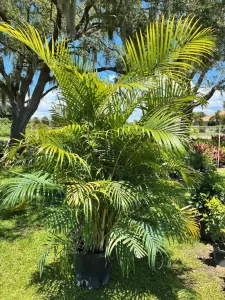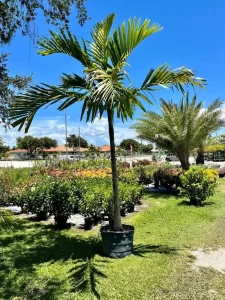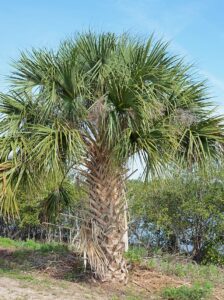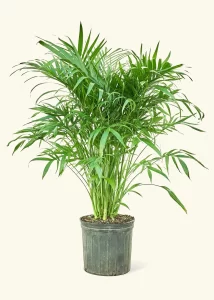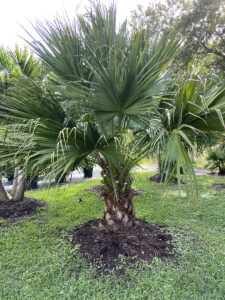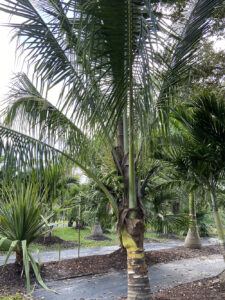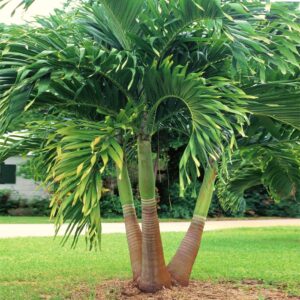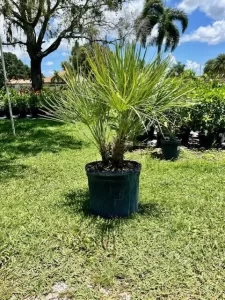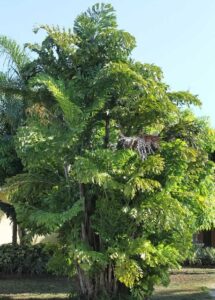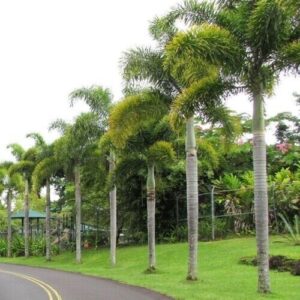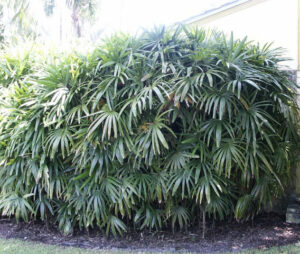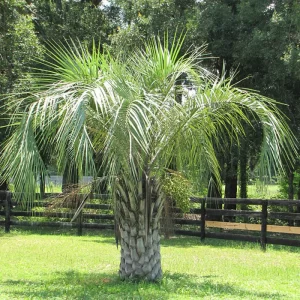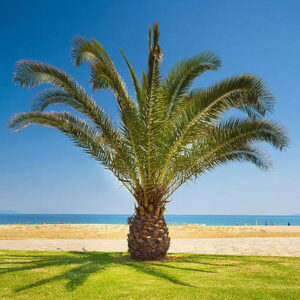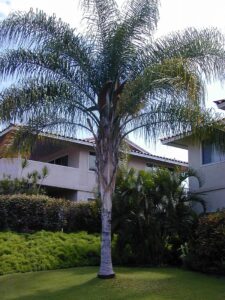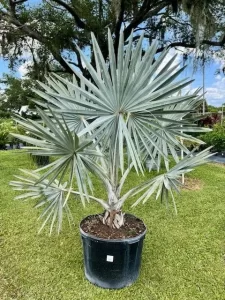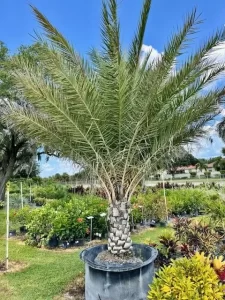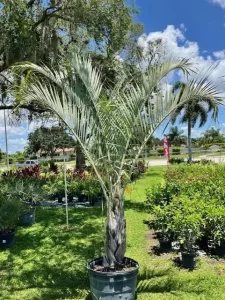PLANT CATALOG
Dypsis lutescens - Areca palms are slow to moderate growers for sun or shade and can reach heights of 15 to 20 feet.
They're wider at the top - sometimes 8 to 10 feet or more in diameter - so allow enough room for the palm to grow a tropical canopy over nearby plants.
Zone 10 is best, though you can use an Areca in a protected spot in warmer areas of Zone 9B that border 10A.
You may see leaf tip burn after most winters, even in Zone 10. (See Plant Care below for trimming info.)
This palm is moderately salt-tolerant.
Ptychosperma elegans - Fragrant pure white blossoms, nearly 2 to 3 inches across, meet carefree growth, setting the August Beauty Gardenia apart. In fact, this no-nonsense shrub will bloom for up to three months at a time, signaling the season in the most fragrant, luscious way.
This palm is a moderate grower and can even be grown indoors with enough height and light to let it thrive. Alexanders are moderately drought-tolerant once they're well-established. Since it's self-cleaning, you won't have to worry about removing dead fronds when the palm is tall.
Hyophorbe lagenicaulis - Prized for its one-of-a-kind look, the Bottle Palm sets itself apart, with a trunk shaped like an antique bottle of Caribbean rum and a standout silhouette that adds immediate value to gardens.
Though it can be cold-sensitive, this palm is an outstanding accent palm for tropical garden beds or sheltered entry areas. Its small size and striking appearance enhance formal or eclectic landscapes.
The fronds are few but long and graceful.
Sabal palmetto - The sabal palm, or cabbage palm, is native to Florida and coastal regions of North and South Carolina and Georgia, and is the state tree of both South Carolina and Florida. The name "cabbage palm" comes from its edible immature leaves, or "heart," which has a cabbage-like flavor. Sabal palms have curved, costapalmate, fan-shaped leaves with blades 3–4 feet long and petioles 3–6 feet long. When free of nutrient deficiencies, this species has a full, round canopy atop a trunk 10–16 inches in diameter and up to 40 feet in height (Figure 1). Branched inflorescences produced during the late spring months usually extend beyond the leaves in the canopy and contain thousands of tiny, creamy-white, fragrant flowers that attract bees.
Chamaedorea cataractarum - The cat palm is a beautiful, fluffy little palm you can grow as an accent, backdrop or short, dense screen.
A cat is similar in looks to an areca palm, except the leaf stems (petioles) are green, whereas the areca's are golden yellow. This smaller palm works in places where the areca would be too large.
Livistona Chinensis - This tropical palm is loved for the way its fronds arch up and then “spill” down, giving an appearance similar to fountain water! Better yet, these fronds can grow up to 40 to 60 inches long!
The Chinese Fan Palm is a subtropical tree that can be found natively in Southeast Asia and is commonly found in Japan, southeast China, Taiwan, or Hainan. It has popularity in South Africa as well as parts of the US too, Florida in particular!
One thing to note, make sure to be extra careful when handling this plant as its leaves can be very sharp and cut you!
Cocos nucifera - The slender, leaning, ringed trunk of the coconut palm rises to a height of up to 25 meters (80 feet) from a swollen base and is surmounted by a graceful crown of giant featherlike leaves. Mature fruits, ovoid or ellipsoid in shape, 300–450 mm (12–18 inches) in length and 150–200 mm (6–8 inches) in diameter, have a thick fibrous husk surrounding the familiar single-seeded nut of commerce. A hard shell encloses the insignificant embryo with its abundant endosperm, composed of both meat and liquid. Coconut fruits float readily and have been dispersed widely by ocean currents and by humans throughout the tropics.
Adonidia merrillii
Christmas Palms are incredibly low-maintenance and don’t require a lot of attention. All you have to decide is where your Christmas Palms will look best. Before you know it, you'll have mature, elegant palm trees in your yard or home, making a beautiful statement.
They are perfect for tight, compact spaces, including areas near sidewalks and driveways. This is the palm that won’t take over or outgrow the area.
However, their crowns are large enough to create relaxing shade areas beneath them. They can be strategically placed to create shade by the pool, in the yard, or driveway to provide cool relief from the heat.
Chamaerops humilis - European fan palm is a slow-growing, clumping palm that expands 8 to 15 feet tall as well as spreads 6 to 10 feet wide. This is the only palm native to Europe and it is hardier than a lot of palms. Plus, it's on the Florida-Friendly plant checklist.
The fine-textured fronds make this palm stick out from various other plants in the landscape. Leaf shade ranges from charming light eco-friendly to magnificent silver. The fronds are held on curved, short trunks. Tiny clusters of yellow blossoms form in the spring and are accompanied by inconspicuous fruits. Young or mature, this palm makes a spectacular sculptural aspect in a yard or in a patio area container.
Caryota mitis - The fishtail palm was named for its unusual leaves - shaped like a jagged fish's tail - which form thick, swirled layers of ruffled fronds.
Fishtails are clustering palms that grow dense and full.
They can be used as privacy screens - especially while they're young - and create a draping mass of deep green leaves among large trunks as they age.
Many homeowners opt for growing a fishtail in an area where they've been considering clumping bamboo.
It won't spread as much or grow as fast as bamboo but gives the same kind of tropical look and privacy.
Wodyetia bifurcata - The enchanting foxtail palm is extremely popular for its perfect proportions, self-cleaning habit, and full, rounded fronds.
A tropical showstopper in the landscape, the foxtail is available in single or multi-trunk specimens. Its smooth gray trunk is topped with a bright green crownshaft and big tufted fronds that resemble the bushy tail of a fox.
The charismatic beauty of this palm works in almost any landscaping, as long as the house itself isn't overwhelmed by its size.
Rhapis excelsa - The Lady Palm has a layered, almost Oriental look - different from most other South Florida palms. A graceful palm for garden areas that allow it room to spread out, this palm grows multiple thin trunks topped with fronds like little green umbrellas.
Even though lady palms are clustering, they grow so slowly that they're easily controlled and won't get away from you. Their rounded shape gives an appealing formal yet tropical appearance.
The Pindo Palm is a medium-sized feathery frond palm that adds undeniable charm to any space. It has wide and elegantly arching fronds that are a gray-green color and a short and stocky trunk that can be styled natural or diamond cut.
This attractive palm slowly grows to a mature height of up to 16 ft making it a suitable tree as a standalone specimen in front of the house or by the pool.
Whereas many feathery frond palm varieties thrive only in subtropical climates, Pindo Palms are the exception as they continue to thrive when the weather gets chilly, earning the recognition for being the most cold-hardy feathery frond palm tree withstanding temperatures down to 20° F and brief periods down to 10° F.
Medium Salt Tolerant
Phoenix canariensis - Canary Island Date Palms, also known as Pineapple Palms are an extremely durable and hardy palm that thrives from the coastal areas of Southern California to the hot Southwestern Deserts. Canary Island Palms are given the common name Pineapple Palm because of their unique crown. They are known for having a large base with an even larger pineapple-shaped crown covered with large arching fronds that can reach 8-12' long.
These palm trees have a wide, beautiful brown colored trunk accented by their pineapple cut crowns and their deep green, exotic-looking fronds, that make this an extremely showy palm and focal point. These are gorgeous when lit up at night and work well by themselves or planted to line walkways, pools, sitting areas, and driveways. Their elegant look is prized not only by businesses, malls, and developers but has quickly become a homeowner favorite.
Phoenix roebelenii - The Pygmy Date Palm has a uniquely sculptural look with full fronds and thick trunks. It is a short, stubby palm with green feathery fronds that makes a striking specimen or accent wherever it is placed.
Typically growing to 15 feet or so while being one of the more drought-tolerant palm trees, Pygmy date palms are very easy to care for. If you’re looking to add a fun, tropical look for less maintenance and space in your garden, consider adding this palm!
Syagrus romanzoffiana - The queen palm is a popular feather-leaved palm with graceful arching leaves. It is one of the hardiest of the tropical-looking palms, being suitable for planting in USDA plant hardiness zone 9B (>25°F). Queen palms are considered to be moderately tolerant of salt spray. They can reach heights up to 50 ft with a spread of 20–25 ft. The smooth gray trunk varies from 8–15 inches in diameter, depending on the seed source and environment, and may contain bulges. Large inflorescences of cream-colored flowers are produced from within the leaves in the canopy during the spring and summer months.
Roystonea oleracea - The huge, gorgeous royal palm tree is thought of by many as the world's most beautiful palm. Smooth trunks of gray to gray-white are topped with bright green crownshafts and long, luxurious, full fronds.
Soaring to heights 80 feet tall, this giant palm tree is one of the most sought-after landscape palms for elegant South Florida homes.
This is a moderately salt-tolerant palm, and it's moderately drought-tolerant as well, once it's established, though it will benefit from regular watering.
Bismarckia nobilis - The exquisite silver bismarck palm is one of the most stunning and desired large palm trees in South Florida. A Silver Bismarck needs plenty of space where its bright color and sheer size won't overwhelm the house or landscape.
The palm itself grows slowly to 30 feet or more...and each thick, fan-shaped frond can reach 10 feet in diameter.
Bismarcks will grow in full sun to part shade but do best in the sunniest areas. These are moderately salt-tolerant palms, drought-tolerant once established.
Hyophorbe verschaffeltii - The stately Spindle Palm is set off by golden stalks when young and pillar-like trunks when mature.
Hardier in nature than its sister species, the Bottle Palm, the spindle adds a somewhat formal yet tropical look to South Florida yards.
Landscape palms like these make impressive single-specimen plants. They can also serve as sentries at a property's entrance or as pretty additions to a tropical palm garden.
This palm's straight and sturdy trunk, with ridges resembling spindles, lends itself to underplanting shrubs and flowers.
Spindles are some of Florida's easier-care palm trees. They love a sunny spot, don't need a lot of water, and their high salt tolerance makes them great beach-side plants.
The classy Sylvester palm is very hardy and low-maintenance - and just the right size for most home landscapes. Sylvester palms are slow growers to an ultimate height of 40 feet.
They stay low to the ground while young, eventually growing an attractive trunk with diamond-shaped leaf-base scars. You can have this "diamond cut" done by a pro to get the best results.
Landscape uses for Sylvester palm
- centerpiece for a wide garden bed
- stand-alone specimen
- accent near the corner of the house
- lining a property line or fence
- on each side of the entrance to a gate or drive (with enough clearance)
- center plant for a circular drive
The unusual shape and coloring of the triangle palm makes it a boldly artistic and formal landscape accent. Instead of a typical crown shaft, triangles have overlapping leaf bases that form on three distinct sides.
The leaves and stems are a unique powder blue-gray or gray-green.
This palm always catches the eye - creating an elegant focal point wherever it's placed in the landscape.
This also means it will draw attention away from other landscape elements, so it's best used alone or as pairs rather than in rows or groups.


